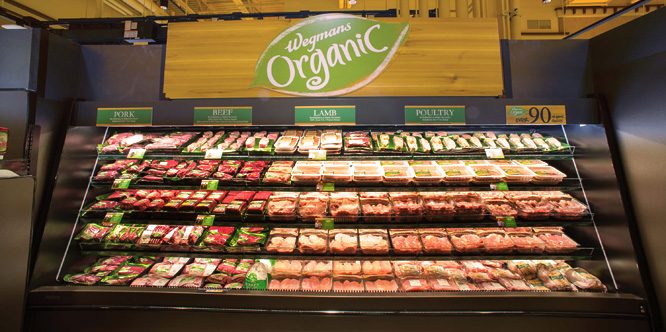
Photo: Wegmans
May 19, 2020
Wegmans breaks price increase news to its customers
In a note to customers, Wegmans said that “retail prices on certain items in our stores will fluctuate in response” to increasing operational and food costs tied to the coronavirus outbreak.
The note from “the Wegman Family” that owns the chain said one factor behind the higher prices is the costs of the chain’s COVID-19 response. Wegmans said, “In the matter of a few short weeks, our stores had to transform into a place where people keep their distance from one another and wear masks to keep those around them safe.”
The second factor is rising product costs “in supply-challenged areas, such as meat.”
“We are doing our very best to work through these challenging times and want to remain transparent about what is happening in the world around us,” Wegmans concluded. “As more businesses begin to open, they too will see that the cost of doing business has changed from a short time ago. We will do our part and share our processes and procedures with other businesses, so they can save time and get their businesses open quicker. The only way to overcome COVID-19 is to all work together.”
So-called “hero pay,” stepped-up cleaning and safety measures, and limits on customer capacity are all seen as profitability strains for grocers. At the same time, the Labor Department last week said prices U.S. consumers paid for groceries jumped 2.6 percent in April, the largest one-month pop since February 1974.
Meat prices in particular are under pressure as dozens of processing plants in the Midwest were forced to close over the last month due to outbreaks among workers.
Some grocers, including Costco, Harris Teeter, Food Lion and Publix, have begun to limit meat purchases.
In a statement to CNN, Publix said that it works “extremely hard to negotiate pricing” with suppliers and tries “to absorb as much of the increase as we can before having to pass along an increase to our customers.” Wegmans appears to be one of the few grocers warning of higher prices.
The pricing pressures come amid a surge in complaints of price gouging across states blamed on the pandemic.
- A Note from the Wegman Family – Wegmans
- Wegmans announces price hikes, cites pandemic as reason – WENY News
- Meat industry butchered by COVID-19 in the Midwest – The Dispatch-Argus
- Tyson Reduces Some Beef Prices as Coronavirus Pushes Grocery-Store Costs Higher – The Wall Street Journal
- Grocers react to sharp spike in grocery food prices, consumer concerns of price-gouging – CNN
- Hundreds of Price Gouging Complaints Filed During Coronavirus Pandemic – NBC San Diego
- It’s time for Congress to establish a federal price gouging law – Amazon.com
Discussion Questions
DISCUSSION QUESTIONS: In what ways should price increases be explained, if at all, to consumers and does that change amid the pandemic? Are public statements such as Wegmans, in-store signage or prepping in-store associates for customer queries the best path to sharing such information?
Poll
BrainTrust
Richard Hernandez
Merchant Director
Ian Percy
President, The Ian Percy Corporation
Recent Discussions







IMO, the general public has no clue as to how a supply chain works or how the cost builds at each stage from beginning to end. And there is little awareness of how razor-thin most of the profit margins are along that same path. So we whine because a carton of eggs goes up 65 cents or that a single lime costs 35 cents. I love a good bargain as much as anyone, but for goodness’ sake, let’s stop every once in a while and think about what it takes to get those eggs and limes to us.
What the public needs is education. The trick is how best Wegmans can create the lesson plan without looking like it’s whining along with the rest of us. Tony Orlando, if you’re reading this today – I’d love to know what the NET profit is on a carton of eggs! Just a guess is fine.
It is always good to be transparent with your customers, positive or negative. Wegmans is explaining the changes and why in easy to understand language. I would hope other retailers would follow suit with similar communication.
Brands that have built their credibility over the years with transparency and empathy, can afford to put that credibility to use. They can do the right thing in these extraordinary circumstances. They can pass on some of the expenses to the consumers while retaining hero pay and addressing other pandemic specific challenges.
As always, open communication and transparency is the best policy – safety procedures, recalls, price increases- anything that impacts customers, particularly negatively. Wegmans has done it the right way.
I’m of the “paint your problems in bright colors” school, Suresh, and you are sure on the right track. If people knew that a modest price increase meant a store employee who served them got a benefit so they could look after their family, it would gladly be paid. People like helping people. At Great Clipps for a haircut the other day, another customer gave a large tip to be shared among the three stylists. As that was done, it made the whole place happy including customers and we all wanted to help out more than usual.
Wegmans’ choice of communication is what shoppers want, understand and need. Full transparency engenders loyalty, even if the news if bad. Wegmans continues to be a leader in the grocery industry.
As I have said many times, the customer’s perception is the reality retailers have to deal with. Prior to the arrival of COVID-19 grocery shoppers saw the aisles full of customers and knew how much they spent on grocery and rightly assumed supermarkets had high sales. To them high sales meant good, if not, high profits. They didn’t read the trade press or have investments in the publicly traded companies so they would have no idea of the thin margins supermarkets operate on.
Explanations at store level or in the press are likely to have little impact on the consumer acceptance of any price increases. In-store signage can convey the new pricing to the customers. Frankly I doubt they care why the price has gone up, only that it has.
Every brand has a different relationship with its customers. If it’s a mercenary, price-based relationship, then explaining every price increase certainly is not going to encourage shopping. However if it’s more in the true/cult realm (like I believe Wegmans tends to be), then having a more transparent dialogue – especially one that appeals to the sense of reason and humanity of all involved – will be well received and engender more loyalty at the end of the day.
I agree with Ian Percy; the general public has no clue as to how a supply chain works. All they hear is the media screaming about price hikes, but not the reason why. The media makes it sound like retailers are raising prices just because they can when that’s not the case at all.
Wegmans’ up front communication with its customers is no surprise to me; the retailer has always been a class act. Telling your customers why things are changing, even temporarily, is a smart move. Loyal customers want to be informed.
I like price transparency. In some instances, such as during a crisis, it’s good to let customers know the “why” behind certain decisions. When there was a tariff imposed on imported materials a company explained to the customers why the price was increased and what they were doing to minimize the impact. The price increase could have been a PR problem, but the company’s reaction saw it as a PR opportunity. A great case study in how to manage bad news for the customer.
As Richard noted, transparency is always the best strategy. That being said, Wegmans needs to tread carefully during these times. While some customers will be empathetic to meat plant closures resulting in availability shortages and potential increases, others will be less than receptive to grocers who have obviously seen dramatic revenue spikes as a result of the pandemic and won’t want to be the ones to carry the costs for sneeze-guards or employee bonuses. For those who do communicate these types of increases, honest emails from company leadership and founders tend to be a safer way of being able to show a more heartfelt outreach vs. in-store signage.
The simple answer to the question is not a single choice but all of the above. In today’s world the more communication the better.
I like the transparency, but just as much as the idea that the prices could “fluctuate in response” to conditions. That feels more real and reassuring than simply raising the prices, with no end in sight. Of course there may be suspicion of price gouging, whether it is happening or not.
I’m in the “if at all” camp: much like a bank telling you they have a web site, I don’t think it’s necessary to point out what’s obvious just by looking at the package. That having been said, related info such as a shortage might merit a note, since a customer could readily confuse an ongoing issue with a momentary one.
Even before the pandemic, upscale grocers like Wegmans were battling competition from mass retailers who had begun to carry higher-quality goods at low prices. Now, it is crucial for Wegmans and other upscale grocers to enhance the customer service they are known for, which includes being transparent about how and why their business practices may need to change.
Wegmans is following the Golden Rule for communicating price increases – don’t just state the what, explain the why. In a pre-COVID-19 world, grocery shoppers were fairly savvy on prices for their everyday items like milk, eggs, bread, etc. but not so much for the less frequent items. However, in the social distancing digital world, transparency makes comparing prices very easy. Once loyal shoppers that are cash constrained are now evaluating which retailer will give them the most value for price. Communicating a price increase is always a double-edged sword, but if it has to be done then follow the Golden Rule like Wegmans. Furthermore, they are being very clear that the increase is not a blanket across the entire store but surgically implemented based on supply chains being overwhelmed.